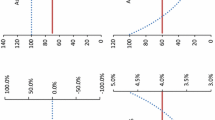Abstract
This paper considers accounting-based valuation formulae. Its initial focus is on two problems related to residual income valuation (RIV). First, insofar valuation depends on theresent value of expected dividends per share, applying RIV requires clean surplus accounting on a per share basis. Awkwardly, equity transactions that change the number of shares outstanding generally imply eps ≠ Δ bvps − dps. A clean surplus equality holds only if one “re-conceptualizes” either end-of-period bvps or eps as a forced “plug”. Second, one cannot circumvent the per share issue by evaluating RIV on a total dollar value basis unless one introduces relatively subtle MM-type restrictions. In light of RIV’s unsatisfactory aspects, the paper proposes an alternative to RIV. This new approach maintains a strict eps-focus. It derives by replacing bvps t in RIV with eps t +1 capitalized (i.e. divided by r). One obtains a formula such that the current market price equals next-period expected earnings capitalized plus the present value of expected abnormal earnings growth, referred to as AEG. A number of propositions then demonstrate the advantages of the AEG approach as compared to RIV. These results follow because eps t+1 capitalized generally approximates market price better than bvps t .
Similar content being viewed by others
References
W. H. Beaver (1998) Financial Reporting: An Accounting Revolution EditionNumber3rd edition Englewood Cliffs New Jersey, Prentice Hall
L. A. Bernstein J. J. Wild (1997) Financial Statement Analysis: Theory Application and Interpretation McGraw-Hill Irwin
V. Bernard (1995) ArticleTitleThe Feltham-Ohlson Framework: Implications for Empiricists Contemporary Accounting Research 11 733–147
Botosan, C. and M. Plumlee. (2002). “Estimating Expected Cost of Equity Capital: A Theory-based Approach”
R. P. Brief R. A. Lawson (1992) ArticleTitleThe Role of Accounting Rate of Return in Financial Statement Analysis The Accounting Review 67 IssueID2 411–426
Christensen J. A. and J. S. Demski. (2003). Accounting Theory: An Information Content Perspective. McGraw-Hill Irwin
Christensen, P. O. and G. A. Feltham. (2003). Economics of Accounting: Volume I Information in Markets, Kluwer Academic Publishers
J. Claus J. Thomas (2001) ArticleTitleEquity Premia as Low as Three Percent? Evidence From Analysts’ Earnings Forecast for Domestic and International Stock Market Journal of Finance 56 IssueID5 1629–1666 Occurrence Handle10.1111/0022-1082.00384
P. Easton (2004) ArticleTitlePE Ratios, PEG Ratios, and Estimating the Implied Expected Rate of Return on Equity Capital The Accounting Review 79 IssueID1 79–95
Easton, P. G., Taylor, P. Shroff and T. Sougiannis. (2002). “Using Forecasts of Earnings to Simultaneously Estimate Growth and the Rate of Return on Equity Investment.” Journal of Accounting Research, 657–676
Fairfield, P. M. (1994). “P/E, P/B and the Present Value of Future Dividends.” Financial Analysts Journal, 23–31
G. A. Feltham J. A. Ohlson (1995) ArticleTitleValuation and Clean Surplus Accounting for operating and Financial Activities Contemporary Accounting Research 11 689–731
W. Gebhardt C. Lee B. Swaminathan (2001) ArticleTitleToward an Implied Cost of Capital Journal of Accounting Research 39 IssueID1–June 2002 135–176 Occurrence Handle10.1111/1475-679X.00007
Gjesdal, F. (1999). “Steady State Growth Valuation Model: A Note on Accounting and Valuation,” Working Paper, Norwegian School of Economics and Business Administration
D. Gode P. Mohanram (2003) ArticleTitleInferring the Cost of Capital Using the Ohlson-Juettner Model Review of Accounting Studies 8 IssueID4 399–431 Occurrence Handle10.1023/A:1027378728141
Hutton, A. (2000). “A Valuation Framework for Quantitative Research.” Harvard Business School Case, N9–100–088
Ohlson, J. A. and B. E. Juettner-Nauroth. (2004). “Expected EPS and EPS Growth as determinants of Value, ” This issue of Review of Accounting Studies
J. A Ohlson (1995) ArticleTitleEarnings, Book Values, and Dividends in Equity Valuation Contemporary Accounting Research 11 661–687
Ohlson, J. A. (2001). “Earnings, Book Values and Dividends in Equity Valuation: An Empirical Perspective,” Contemporary Accounting Research
J. A. Ohlson X.-J. Zhang (1998) ArticleTitleAccrual Accounting and Equity Valuation Journal of Accounting Research 36 85–111
J. A. Ohlson X.-J. Zhang (1999) ArticleTitleOn the Theory of Forecast Horizon in Equity Valuation Journal of Accounting Research 37 437–449
J. A. Ohlson (2002) ArticleTitle“Discussion of Residual Income and Value-Creation: The Missing Link Review of Accounting Studies 7 247–251 Occurrence Handle10.1023/A:1020234304861
J. A. Ohlson (1999) ArticleTitleDiscussion of An analysis of Historical and Future-Oriented Information in Accounting-Based Security Valuation Models Contemporary Accounting Research 16 IssueID2 381–384
Ozair, M. (2003) “Growth in Expected Earnings and Equity Valuation”, Unpublished Working Paper, Stern School of Business, NYU
K. G. Palepu V. L Bernard P. M. Healy (2000) Business Analysis and Valuation South-Western Publishing, Co Cincinnati, Ohio
Peasnell, K. V. (1981) “On Capital Budgeting and Income Measurement”, Abacus, 52–67
Peasnell, K. V. (1982) “Some Formal Connections Between Economic Values and Yields and Accounting Numbers Journal of Business Finance and Accounting, 361–381
S. H. Penman (1997) ArticleTitleA Synthesis of Equity Valuation Techniques and the Terminal Value Calculation for the Dividend Discount Model Review of Accounting Studies 2 303–323 Occurrence Handle10.1023/A:1023688704798
Penman, S. (2004). Financial Statement Analysis Security Analysis and Security Valuation, 2nd edition. McGraw-Hill Irwin
L. Revsine D. W. Collins W. B. Johnson (1999) Financial Reporting and Analysis Prentice Hall New Jersey
Ryan, S. (1988). “Structural Models of the Accounting Process and Earnings,” Ph.D. Dissertation, Stanford University
L. Soffer R. Soffer (2003) Financial Statement Analysis: A Valuation Approach Prentice Hall New Jersey
White, G. I., A. C. Sondhi and H. D. Fried. (2003) The Analysis and Use of Financial Statements, John Wiley and Son’s Inc
X. J Zhang (2000) ArticleTitleConservative Accounting and Equity Valuation Journal of Accounting and Economics 29 125–149 Occurrence Handle10.1016/S0165-4101(00)00016-1
Author information
Authors and Affiliations
Additional information
*An earlier version of this paper was titled “Residual Income Valuation The Problems”.
Rights and permissions
About this article
Cite this article
Ohlson, J.A. On Accounting-Based Valuation Formulae*. Rev Acc Stud 10, 323–347 (2005). https://doi.org/10.1007/s11142-005-1534-4
Issue Date:
DOI: https://doi.org/10.1007/s11142-005-1534-4




